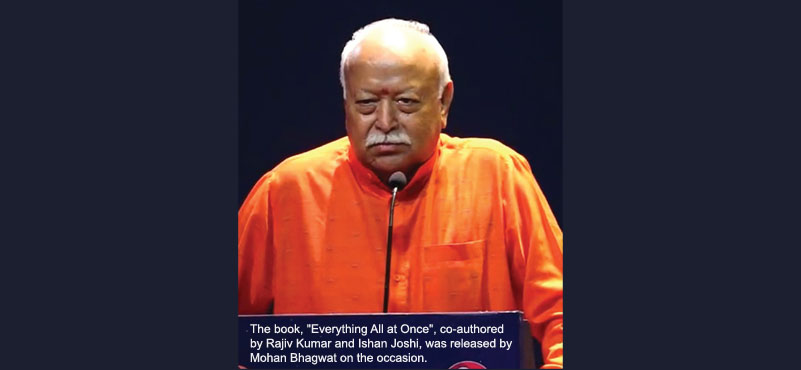The NDA’s emphatic mandate was a staggering 202 out of 243 seats – a tsunami in more ways than one- in Bihar, which is India’s third-most populous state, with 74 million registered voters across 243 assembly constituencies.
For Whom The Bell Tolls?
The narrative of stable governance and incremental development through infrastructure and social engineering decisively carried the day for the NDA combine spearheaded by the twin forces of BJP and JD (U)- in a manner so tellingly that few forecasters had forecasted.
Paradigm Shift from Fragmentation to Bipolarity
The NDA secured 47.2% of the vote while the Mahagathbandhan (MGB) obtained 37.3%, a gap of nearly 10 percentage points. While this paradigm shift from fragmentation to bipolarity was, by any standard, a huge win, it demonstrated the structural transformation of Bihar’s party system over the past decade.

Growth Prospects
The results at the hustings, therefore, delivered more than just electoral clarity; it opens a window for long-awaited political stability, policy continuity, and tighter coordination between Patna and the Centre. This alignment, often framed as the “double-engine” advantage, provides Bihar with a rare opportunity to advance high-priority development commitments: the creation of one crore jobs, an ambitious surge in capital expenditure, new expressways and airports, expanded social and physical infrastructure, and large-scale women-led livelihood programmes. With reduced political volatility and clearer policy signalling, the conditions for sustained investment and large infrastructure rollouts become substantially more favourable. The state can now more realistically pursue the employment-linked growth sequence it has long aspired to — construction-driven expansion, translating into stronger services activity, and eventually feeding industrial development.
Bridging the Chasm between Promises and Policy Implementation
To be sure, all this is welcome. However, turning these promises, especially the politically resonant but economically complex pledge of “one crore government job”, into durable economic outcomes will demand far more than political will. It will require a carefully phased roadmap, predictable multi-year funding, deepened partnerships with the Centre, and calibrated use of PPP models. Most importantly, Bihar will need to exercise fiscal discipline at a time when its commitments outstrip current fiscal capacity. Without this discipline, the risk is that large but short-lived schemes proliferate, ballooning expenditure without building self-sustaining growth engines.
The implementation hurdles are substantial. Land acquisition continues to be a systemic bottleneck, slowing both public infrastructure projects and private industrial investments. Regulatory clearances, environmental assessments, and long project gestation periods add layers of complexity.
Equally pressing is the need to strengthen Bihar’s project-management architecture — from departmental capacity to contractor ecosystems — to handle the scale and sophistication of the proposed infrastructure push.
On the employment front, prioritising demand-driven, productivity-enhancing jobs over sheer numerical targets is critical. If the job-creation drive is not closely integrated with private-sector expansion, many “new jobs” may end up confined to low-wage, temporary positions under government asset-creation schemes, offering limited spillovers to the broader economy.
Delivering on the scale envisioned will therefore hinge on a combination of sustained central transfers, catalytic private investment, innovative financing mechanisms, such as blended finance and annuity-based PPPs, and prudent debt management. Bihar must also create a more predictable investment climate — from industrial land banks to streamlined approvals — if it hopes to attract manufacturing and logistics players that can anchor long-term job growth.
Significance of Election Results Transcending Bihar
The significance of this verdict extends well beyond Bihar for the opposition parties in general and Rahul Gandhi in particular, who has now accumulated 95 electoral defeats in two decades (an unenviable record of sorts, if not a global record!). This situation reminds me of the famous lines by Nida Fazli (1938-2016):
“सफ़र में धूप तो होगी जो चल सको तो चलो
सभी हैं भीड़ में तुम भी निकल सको तो चलो
किसी के वास्ते राहें कहाँ बदलती हैं
तुम अपने आप को ख़ुद ही बदल सको तो चलो
यहाँ किसी को कोई रास्ता नहीं देता
मुझे गिरा के अगर तुम सँभल सको तो चलो
कहीं नहीं कोई सूरज धुआँ धुआँ है फ़ज़ा
ख़ुद अपने आप से बाहर निकल सको तो चलो
यही है ज़िंदगी कुछ ख़्वाब चंद उम्मीदें
इन्हीं खिलौनों से तुम भी बहल सको तो चलो”
An English translation could be :
The journey will have scorching sunlight – if you can walk, then go forth!
When do life’s paths ever change for someone else’s sake?
If you can change yourself on your own, then go forth!
Over here, no one gives way to anyone else.
If by knocking me down, you can balance yourself, then go forth!
There is no sun here; smoke engulfs all surroundings.
If you can withdraw from your own self, then go forth!
Life is but a few dreams and a handful of hopes.
If you too can be amused by these toys, then go forth!
All are lost amongst the crowd – if you too can escape, then go forth!
Gazing into the crystal ball clearly suggests that at the national level, the results strengthen the Centre’s political narrative in the run-up to the next general elections and present a model of how large infrastructure pushes can be paired with targeted youth and women’s livelihood programmes. If successfully executed, Bihar’s infrastructure pipeline comprising of new expressways, airports, industrial corridors, multimodal logistics hubs could reshape investor perceptions about India’s emerging growth geographies. In doing so, it may begin redirecting private capital flows toward eastern India, a shift with long-term macroeconomic implications. Difficult but by no means undoable. Failure is not an option.
In essence, the verdict- loud and clear- augurs well and provides an impoverished Bihar with an unprecedented mandate and a moment of structural opportunity.
It is, however, important to bridge the chasm between promise and reality, the lofty claims and concrete action in a manner that is at once time-bound and effective. Realising its promise and walking the talk will depend on whether political stability can be converted into administrative agility, financial prudence, and sustained economic transformation to meet the challenges of the present and the expectations of the future.
ABOUT THE AUTHOR
 Dr. Manoranjan Sharma is Chief Economist, Infomerics, India. With a brilliant academic record, he has over 250 publications and six books. His views have been cited in the Associated Press, New York; Dow Jones, New York; International Herald Tribune, New York; Wall Street Journal, New York.
Dr. Manoranjan Sharma is Chief Economist, Infomerics, India. With a brilliant academic record, he has over 250 publications and six books. His views have been cited in the Associated Press, New York; Dow Jones, New York; International Herald Tribune, New York; Wall Street Journal, New York.








